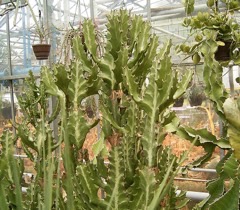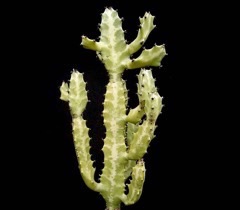 |
|
Frank Vincentz on Wikimedia.org |
 |
| Frank Vincentz on Wikimedia.org |
Translate this page:
Summary
Physical Characteristics

 Euphorbia lactea is an evergreen Shrub growing to 5 m (16ft) by 3 m (9ft) at a medium rate.
Euphorbia lactea is an evergreen Shrub growing to 5 m (16ft) by 3 m (9ft) at a medium rate.
See above for USDA hardiness. It is hardy to UK zone 10.
Suitable for: light (sandy), medium (loamy) and heavy (clay) soils, prefers well-drained soil and can grow in nutritionally poor soil. Suitable pH: mildly acid, neutral and basic (mildly alkaline) soils. It can grow in semi-shade (light woodland) or no shade. It prefers dry or moist soil and can tolerate drought.
UK Hardiness Map
US Hardiness Map
Synonyms
Euphorbia lactea Roxb. [Illegitimate]
Plant Habitats
Edible Uses
All parts are poisonous: ingestion, dermatitis, or severe eye irritant. Symptoms include: Nausea, vomiting, diarrhea when ingested; redness, swelling, blisters after some delay following contact with skin.
References More on Edible Uses
Medicinal Uses
Plants For A Future can not take any responsibility for any adverse effects from the use of plants. Always seek advice from a professional before using a plant medicinally.
None Known
References More on Medicinal Uses
The Bookshop: Edible Plant Books
Our Latest books on Perennial Plants For Food Forests and Permaculture Gardens in paperback or digital formats.

Edible Tropical Plants
Food Forest Plants for Hotter Conditions: 250+ Plants For Tropical Food Forests & Permaculture Gardens.
More

Edible Temperate Plants
Plants for Your Food Forest: 500 Plants for Temperate Food Forests & Permaculture Gardens.
More

More Books
PFAF have eight books available in paperback and digital formats. Browse the shop for more information.
Shop Now
Other Uses
Carbon Farming Solutions - Agroforestry Services: living fence (Agroforestry is a land use management system in which trees or shrubs are grown around or among crops or pastureland). Pot plant. Indoor plant. A good specimen, hedge or container plant.
Special Uses
Carbon Farming
References More on Other Uses
Cultivation details
Agroforestry Services: Living fence Management: Coppice Minor Global Crop
Climate: tropical. Humidity: arid to humid. Prefers areas of full sunlight and dry soil to moist well drained soil. Cannot tolerant wet soil. Full sun to part shade. Intolerant of frost. Hardy to hardy to 5°C. Carbon Farming Solutions - Cultivation: minor global crop. Management: coppice (Describes the non-destructive management systems that are used in cultivation) [1-1].
Carbon Farming
-
Agroforestry Services: Living fence
Simply managed rows of shrubs and trees.
-
Management: Coppice
Cut to the ground repeatedly - resprouting vigorously. Non-destructive management systems maintaining the soil organic carbon.
-
Minor Global Crop
These crops are already grown or traded around the world, but on a smaller scale than the global perennial staple and industrial crops, The annual value of a minor global crop is under $1 billion US. Examples include shea, carob, Brazil nuts and fibers such as ramie and sisal.
References Carbon Farming Information and Carbon Sequestration Information
Temperature Converter
Type a value in the Celsius field to convert the value to Fahrenheit:
Fahrenheit:
The PFAF Bookshop
Plants For A Future have a number of books available in paperback and digital form. Book titles include Edible Plants, Edible Perennials, Edible Trees,Edible Shrubs, Woodland Gardening, and Temperate Food Forest Plants. Our new book is Food Forest Plants For Hotter Conditions (Tropical and Sub-Tropical).
Shop Now
Plant Propagation
Euphorbia cuttings in Spring/Summer
Other Names
If available other names are mentioned here
Candle-stick tree, False cactus, Mottled candle stick tree, African milk plant, Elkhorn, Frilled fan, Milkstripe euphorbia, Mottled candlestick, Milk striped euphorbia, Hat-rack-cactus, Hatrack cactus, Dragon bones, Candelabra spurge, Dragoon bones tree, Candelabra Cactus, Cactus Candelabre, Caper Spurge, Mottled spurge, Coral Cactus, Euphorbe lactée, Pokok sesudu, ??????? ????????, Lechero de lindero, Escambrón, Candelero, Cardon, Moteado, Marmoreuforbia
Native Range
Coming Soon
Weed Potential
Right plant wrong place. We are currently updating this section.
Please note that a plant may be invasive in one area but may not in your area so it's worth checking.
None Known
Conservation Status
IUCN Red List of Threatened Plants Status : This taxon has not yet been assessed

| Related Plants
|
| Latin Name | Common Name | Habit | Height | Hardiness | Growth | Soil | Shade | Moisture | Edible | Medicinal | Other |
| Acalypha australis | Asian copperleaf | Annual | 0.5 |
0-0
| | LMH | SN | M | 0 | 1 | |
| Alchornea castaneifolia | Iporuru | Tree | 8.0 |
10-12
| F | LMH | SN | MWe | 0 | 4 | 2 |
| Alchornea cordifolia | Christmas Bush | Shrub | 8.0 |
10-12
| M | LMH | N | DMWe | 2 | 4 | 3 |
| Aleurites cordata | Japan Wood-Oil Tree | Tree | 7.0 |
9-11
| | LM | SN | M | 0 | 0 | 2 |
| Aleurites fordii | Tung Tree, Tung Oil Tree, Wood Oil Tree China | Tree | 7.0 |
8-10
| F | LM | SN | M | 1 | 3 | 3 |
| Aleurites moluccanus | Candle Nut, Country Walnut | Tree | 20.0 |
10-12
| F | LMH | N | DM | 3 | 3 | 4 |
| Caryodendron orinocense | Taccy Nut, Nuez de Barinas | Tree | 25.0 |
10-12
| F | LMH | N | M | 3 | 1 | 2 |
| Chrozophora tinctoria | Dyer's Croton, Giradol | Perennial | 0.0 |
0-0
| | LMH | SN | M | 1 | 0 | 2 |
| Cnidoscolus aconitifolius | Tree Spinach, Tread Softly, Cabbage Star, Chaya | Shrub | 5.0 |
9-11
| F | LMH | SN | M | 4 | 3 | 3 |
| Cnidoscolus elasticus | Highland chilte | Shrub | 1.0 |
9-11
| F | LMH | N | DM | 0 | 0 | 4 |
| Croton lechleri | Sangre De Grado, Dragon's blood | Tree | 12.0 |
10-12
| F | LMH | N | M | 0 | 4 | 1 |
| Croton megalocarpus | Croton tree | Tree | 25.0 |
10-12
| F | LM | N | M | 0 | 2 | 4 |
| Croton palanostigma | Sangre De Grado, Dragon's blood | Tree | 12.0 |
10-12
| F | LM | N | M | 0 | 4 | 2 |
| Croton salutaris | Sangre De Grado, Dragon's blood | Tree | 12.0 |
10-12
| F | LM | N | M | 0 | 4 | 0 |
| Croton tiglium | Croton Oil Plant. Croton, Purging croton. | Tree | 7.0 |
10-12
| M | LMH | N | DM | 0 | 3 | 2 |
| Euphorbia abyssinica | Candelabra Spurge | Tree | 7.5 |
10-12
| M | LM | SN | D | 0 | 2 | 3 |
| Euphorbia antisyphilitica | Candelilla | Shrub | 1.0 |
7-10
| | LM | N | DM | 2 | 0 | 4 |
| Euphorbia corollata | Wild Spurge, Flowering spurge | Perennial | 1.0 |
4-8
| | LM | SN | DM | 0 | 2 | 2 |
| Euphorbia drummondii | Caustic Weed | Annual | 0.2 |
-
| | LM | N | DM | 0 | 1 | |
| Euphorbia esula | Leafy Spurge. Green spurge | Perennial | 1.0 |
3-9
| F | LMH | SN | DM | 0 | 0 | 4 |
| Euphorbia helioscopia | Madwoman's Milk | Annual | 0.4 |
-
| | LM | N | DM | 1 | 2 | |
| Euphorbia hirta | Asthma Weed, Pill-Bearing Spurge | Annual | 0.3 |
-
| | LM | N | DM | 1 | 3 | |
| Euphorbia humifusa | | Annual | 0.2 |
-
| | LM | N | DM | 1 | 2 | |
| Euphorbia intisy | Intisy, Pencil Plant | Shrub | 5.0 |
10-12
| F | LM | SN | D | 0 | 0 | 3 |
| Euphorbia ipecacuanhae | American Ipec | | 0.0 |
-
| | LMH | SN | M | 0 | 1 | |
| Euphorbia lathyris | Caper Spurge, Moleplant | Annual/Biennial | 1.0 |
5-9
| | LMH | SN | DM | 1 | 2 | 3 |
| Euphorbia marginata | Mountain Snow, Ghost Spurge, Ghost Weed | Annual | 0.6 |
4-8
| F | LM | N | DM | 1 | 1 | 3 |
| Euphorbia neriifolia | Fleshy spurge, Hedge Euphorbia, Oleander spurge | Shrub | 4.0 |
10-12
| F | LM | SN | D | 2 | 2 | 2 |
| Euphorbia pekinensis | Da Ji | Perennial | 0.6 |
-
| | LM | N | DM | 0 | 3 | |
|
|
Growth: S = slow M = medium F = fast. Soil: L = light (sandy) M = medium H = heavy (clay). pH: A = acid N = neutral B = basic (alkaline). Shade: F = full shade S = semi-shade N = no shade. Moisture: D = dry M = Moist We = wet Wa = water.
Now available:
Food Forest Plants for Mediterranean Conditions
350+ Perennial Plants For Mediterranean and Drier Food Forests and Permaculture Gardens.
[Paperback and eBook]
This is the third in Plants For A Future's series of plant guides for food forests tailored to
specific climate zones. Following volumes on temperate and tropical ecosystems, this book focuses
on species suited to Mediterranean conditions—regions with hot, dry summers and cool, wet winters,
often facing the added challenge of climate change.
Read More
Expert comment
Author
Haw.
Botanical References
Links / References
For a list of references used on this page please go here
Readers comment
| Add a comment |
|
If you have important information about this plant that may help other users please add a comment or link below. Only comments or links that are felt to be directly relevant to a plant will be included. If you think a comment/link or information contained on this page is inaccurate or misleading we would welcome your feedback at [email protected]. If you have questions about a plant please use the Forum on this website as we do not have the resources to answer questions ourselves.
* Please note: the comments by website users are not necessarily those held by PFAF and may give misleading or inaccurate information.
To leave a comment please Register or login here All comments need to be approved so will not appear immediately.
|
Subject : Euphorbia lactea
|
|
|
|